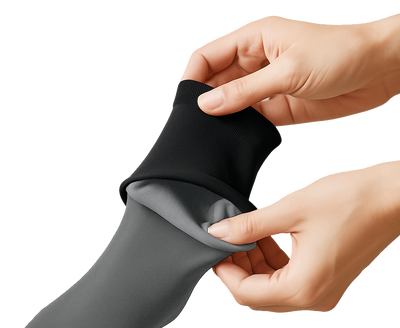How tight should compression socks be?

If you are new to the compression socks industry and were recommended a pair of compression socks, you are probably thinking that there is only one type of compression socks. But that is not the truth. There are many different types of compression socks whose effectiveness depends on a person’s needs.
The main characteristic of compression socks, and what separates them from regular socks, is the compression material they are made of. This material is made to fit firmly around the legs and the feet, and to slightly squeeze these areas. The purpose of the squeezing is to improve blood flow and to prevent and minimize swelling and aches among other benefits.
The compression is also the main thing that differs compression socks from one another. There are around 5 to 10 different levels of compression that socks can be made of. The level of compression represents how tight the socks will fit, or how hard it will squeeze you.
The level of compression is measured in mmHg, which stands for millimeters of mercury that is a manometric unit of pressure.
What is the best level of compression for you?
If your doctor is the one who had recommended or prescribed compression socks to you, he has probably said which level of compression is the best for you.
To determine the benefit of compression socks regarding their levels of compression, you must be aware of your body, your needs, and the problems you experience.

What has inspired you to get compression socks? Maybe you are an athlete that needs good muscle support. Or maybe you are a health worker spending a lot of a day on your feet. Maybe you are pregnant, and you feel extra pressure on your legs. Or maybe you have noticed problems with varicose veins and cold feet.
All these situations call for compression socks. The only question is – which level of compression will benefit me the most?
How tight should compression socks be?
So, if the whole point of compression is to squeeze, should compression socks be tight?
Compression socks should be tight, but they should also comfortable.
When you first put them on, they may feel odd because you are simply not used to this kind of pressure. But, after a while (a few days of wearing them), your body will get used to them, and you will find them super-comfortable.
But can compression socks be too tight?
Yes. They can. If you cannot get used to them, they feel tight and uncomfortable even after some time, which probably means that you are not wearing the right level of compression.
Compression socks that are too tight can restrict your blood-flow rather than encouraging it. The right compression for you should always help you minimize the aches and pain in your legs, and not the other way around.

If you are getting compression socks on your behalf for the first time, we recommend starting with the lowest level of compression and slowly building up if you feel the need. If you have never worn compression socks, even the lowest compression can feel tight when you first put it on.
It is important to remember that when it comes to compression socks, too tight can give you just the opposite of what you need. So, start light or consult a medical professional.
Different levels of compression socks
What level of compression socks do I need?
There are different types of compression socks depending on the level of pressure they provide. There is a range starting from 10 mmHg and going up to 60 mmHg. So, what is the right level of compression for you?
- 10-15 mmHg is a very gentle and light compression. It is perfect for those who experience minor discomfort or pain. They are also good for swollen or tired feet after a long day. They are perfect for work and around the house. If you are not experiencing a lot of trouble, these are the best compression socks for standing all day.
- 15-20 mmHg is the most common level of compression. It is mild but with therapeutic effects. This level of compression is the best for travelers during long flights or long sitting in cars. Also, it is recommended for pregnant women that fight pregnancy edema (swelling).
- 20-30 mmHg is for those who suffer more than occasional swelling and pain, cold feet, and medium to high discomfort. These are thigh compression socks that are good for treating lighter problems with varicose veins. They are also a good choice for pro athletes that are pushing their bodies' limits. They will help with muscle recovery and minimize the chances of strains and cramps.
- 30-40 mmHg is for more severe discomfort. These super tight compression socks are recommended after surgeries or in cases of more serious problems with varicose veins.
- 40-50 mmHg is for severe varicose veins and swelling.
- 50-60 mmHg is for cases of Post-thrombotic syndrome or similar to that.
Which compression socks are the best?
Here is a list of SKINEEZ compression socks ranging from light to thigh compression socks. SKINEEZ compression socks are always comfortable, and what makes them stand out is their skin-reparative properties. For maximum comfort and health, we infused all our garments with a formula of 5 natural moisturizers that will keep your skin hydrated and healthy.

Here is a glance at our products:
SKINEEZ® Graduated Compression Socks are soft, easy to pull on, and deliver hydrating properties to the skin. They are light compression socks great for travel, work, or any lifestyle activities.
SKINEEZ® Compression Socks are incredibly soft, comfortable, and moisturize your skin as you wear them. Easy to put on and breathable, these MILD, 10-15mmHg compression socks stay remarkably soft even after many washings.
For the millions of people who suffer from venous disorders, 20-30 mmHg compression socks help promote venous blood flow. These tights compression socks of 20-30mmHg are the most commonly prescribed compression level typically used to reduce mild to moderate edema (swelling) or “heaviness” in the legs that is caused by poor blood circulation.
SKINEEZ Extra Firm Hydrating Compression 30-40 mmHg is recommended for patients with severe circulatory disorders of the leg. This may be severe swelling or edema, more severe varicose veins, recurrence of venous ulceration in the leg, chronic venous insufficiency, distended, tortuous veins of the legs associated with pregnancy, hypotension, and more.

We offer more options in our shop, so be sure to check it out by clicking here. SKINEEZ proudly makes affordable quality compression garments that nurture the skin, because we think that everybody should have a chance to improve their life.
SKINEEZ also has a specialized Active line for pro sportsmen and athletes that you can check out here.



